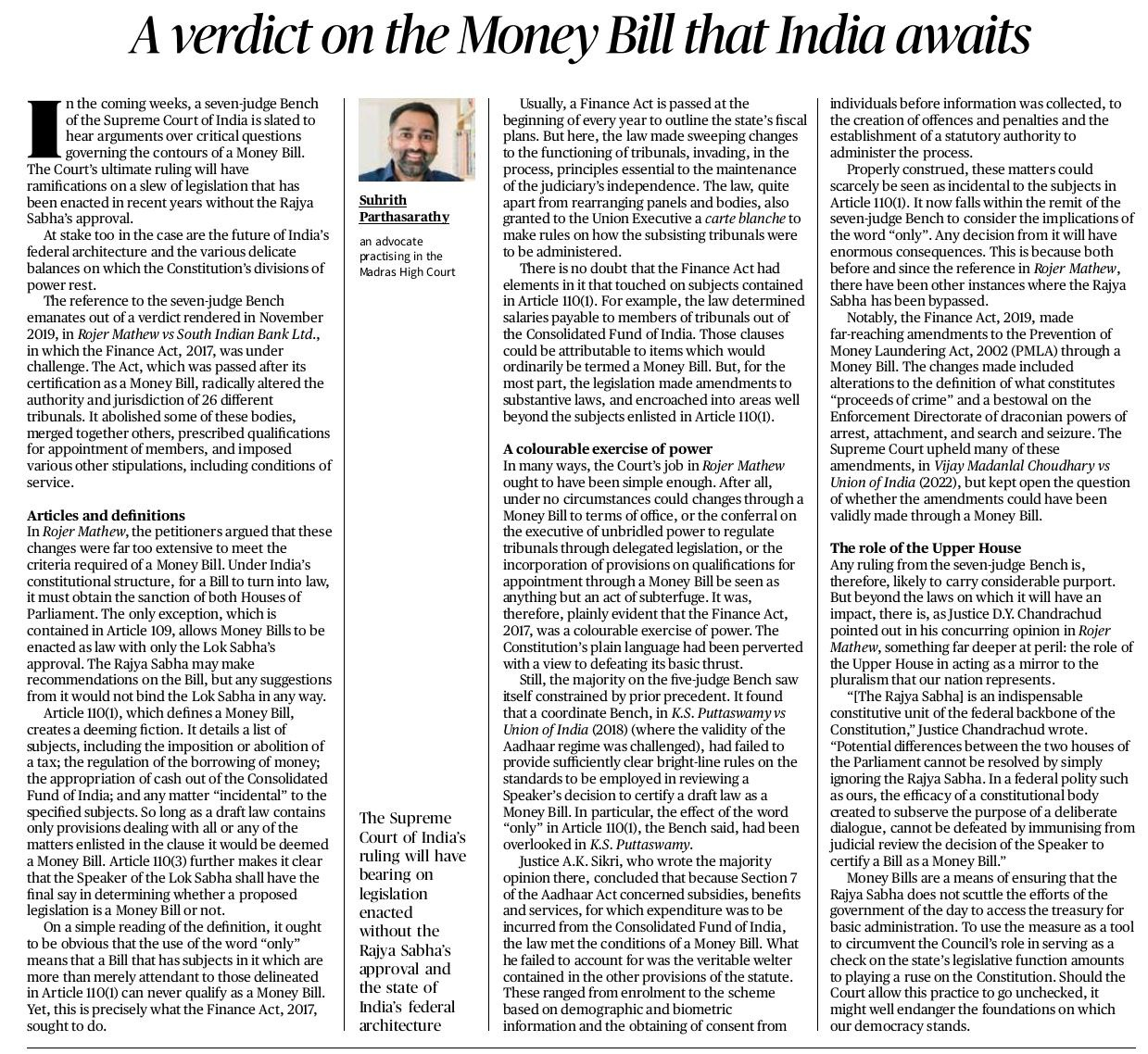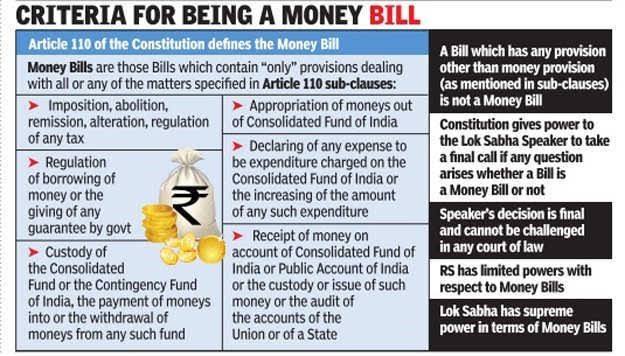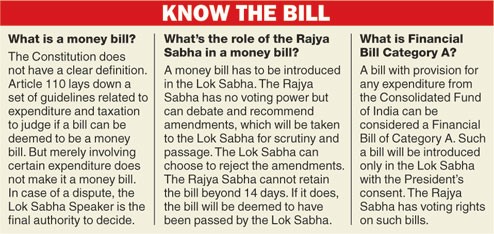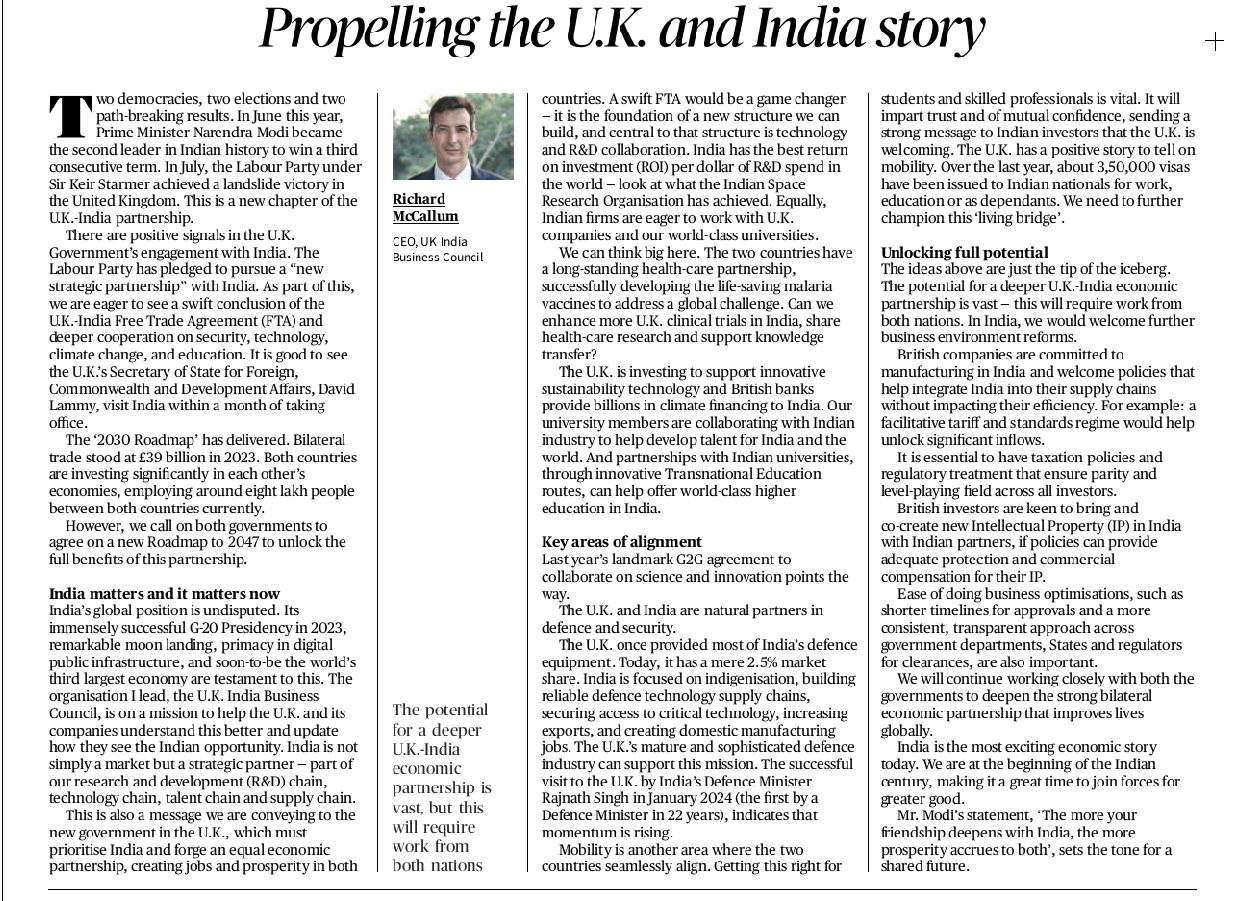The Money Bill controversy
Introduction
The upcoming Supreme Court verdict on the contours of a Money Bill holds significant implications for India’s federal structure and the separation of powers between the legislature and executive.
The case stems from challenges to the Finance Act, 2017, which was passed as a Money Bill despite containing provisions unrelated to finance.
Key Issues
Definition of Money Bill: Article 110(1) of the Constitution defines a Money Bill as one dealing exclusively with matters like taxation, borrowing, and appropriation of funds. The Finance Act, 2017, went beyond these parameters by making sweeping changes to tribunals, including their abolition, merger, and qualification criteria for members.
Speaker’s Discretion: Article 110(3) grants the Speaker of the Lok Sabha final authority to certify a bill as a Money Bill. The Supreme Court is expected to examine the extent of this discretion and whether it can be challenged in court.
Federalism and Separation of Powers: The misuse of Money Bills to bypass the Rajya Sabha’s scrutiny undermines the federal structure and the checks and balances inherent in India’s parliamentary system.
Case Examples
- Finance Act, 2017: This act radically altered the tribunal structure, encroaching upon the judiciary’s independence and exceeding the scope of a Money Bill.
- Aadhaar Act: The Supreme Court, in the S. Puttaswamy case, upheld the Aadhaar Act as a Money Bill based on its provisions related to subsidies and benefits. However, the act contained numerous provisions unrelated to finance, raising questions about the interpretation of “incidental matters.”
- Finance Act, 2019: This act amended the Prevention of Money Laundering Act (PMLA), granting the Enforcement Directorate extensive powers. The Supreme Court upheld these amendments but left open the question of their validity as a Money Bill.
Implications of the Verdict
The Supreme Court’s verdict will clarify the scope of Money Bills and the limits of the Speaker’s discretion. A narrow interpretation upholding the primacy of Article 110(1) would strengthen federalism and protect the Rajya Sabha’s role. Conversely, a broad interpretation could lead to further encroachment on the legislature’s powers and weaken checks on executive authority.
Conclusion
- The Supreme Court’s verdict on Money Bills is crucial for safeguarding India’s federal democracy.
- It must uphold the principle that Money Bills should be confined to matters of finance and prevent their misuse to bypass legislative scrutiny.
- A clear and restrictive definition of Money Bills is essential to maintain the balance of power between the legislature and executive and uphold the integrity of the parliamentary system.
Mains Practice Question |
Q. Discuss the concept of Money Bills in India, highlighting recent controversies surrounding their classification. Analyse the implications of these controversies for federalism and the separation of powers. |
UK-India partnership from the eyes of UK
Introduction
- The UK-India partnership has entered a new phase with significant political and economic developments in both countries.
- In July 2024, the Labour Party achieved a landslide victory in the United Kingdom, signalling a renewed focus on strengthening bilateral relations.
- Political Engagement
- The Labour Party has pledged to pursue a “new strategic partnership” with India.
- The UK Secretary of State for Foreign, Commonwealth and Development Affairs, David Lammy, visited India within a month of taking office, indicating strong diplomatic engagement.
- Economic Cooperation
- The ‘2030 Roadmap’ has been successful, with bilateral trade reaching £39 billion in 20231.
- Both countries are investing significantly in each other’s economies, employing around 800,000 people between them.
- There is a call for a new Roadmap to 2047 to further unlock the potential of this partnership.
- Strategic Importance of India
- India’s global position is strengthened by its successful G-20 Presidency in 2023, a remarkable moon landing, and its primacy in digital public infrastructure.
- India is on track to become the world’s third-largest economy, highlighting its strategic importance.
- Research and Development (R&D) Collaboration
- India offers the best return on investment (ROI) per dollar of R&D spend globally, exemplified by the achievements of the Indian Space Research Organisation (ISRO).
- Indian firms are eager to collaborate with UK companies and universities on technology and R&D projects.
- Healthcare and Sustainability
- The UK and India have a long-standing healthcare partnership, including the development of life-saving malaria vaccines.
- There is potential for enhanced clinical trials, healthcare research, and knowledge transfer between the two countries.
- British banks are providing billions in climate financing to India, supporting innovative sustainability technologies.
- Education and Talent Development
- UK universities are collaborating with Indian industry to develop talent for both India and the world.
- Partnerships with Indian universities through Transnational Education routes are helping to offer world-class higher education in India.
- Defence and Security
- The UK and India are natural partners in defence and security, with a focus on indigenisation and building reliable defence technology supply chains.
- The visit of India’s Defence Minister to the UK in January 2024, the first in 22 years, indicates rising momentum in defence cooperation.
Conclusion
The potential for a deeper UK-India economic partnership is vast, but it requires concerted efforts from both nations. A swift Free Trade Agreement (FTA) would be a game changer, laying the foundation for enhanced collaboration in technology, R&D, healthcare, sustainability, education, and defence. The UK-India partnership is not just about economic gains but also about creating jobs, fostering innovation, and addressing global challenges together.
Mains Practice Question |
Q. Discuss the evolving UK-India partnership in the context of recent political and economic developments. Highlight the key areas of cooperation and the potential benefits of a swift Free Trade Agreement (FTA) between the two nations.
Answer in 250 words. |





